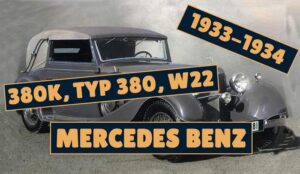Everyone car enthusiast out there wants a classic car, one of the great, vintage, daring, call it whatever you want to, but there’s no downplaying the prestige and swag that comes with having one. It wouldn’t be fair to mention classic cars without saying something about the Mercedes 24/100/140 PS. I’m sure you wouldn’t come across names like this in the automobile industry today, but look at it as the car trying to tell you, ” Hey, I’m classic.”
The numbers tell us a little something about this classic ride. The number “24” defined the car’s tax horsepower, used to determine the annual car tax to be imposed on car owners. The “100” and the “140” were the manufacturer’s claims regarding its power output.
Mercedes 24/100/140 PS – Origin
One of the reasons the Mercedes 24/100/140 was endowed with great technical and mechanical attributes is because it could be considered a crossroad between two great minds. The original plans were drawn by Technical Director Paul Daimler, who later left the company in disagreement with the supervisory board in 1922. Then Ferdinard Porsche later took over in 1923 and completed the Mercedes 24/100/140.
This classic is one of the few models to survive the Daimler regime, with the Benz & Cie merger signed in 1924. In light of the newly merged company, cars being produced were handed the name, “Mercedes-Benz” and the model also acquired the new name, “Typ 630”, being now known as the Mercedes-Benz Typ 630.
Mercedes 24/100/140 PS – Overview
At first, when people bought this car, they only acquired the chassis, which then required them to purchase the body framework from independent builders. There was a list of body types to purchase then, which includes:
- A six-seater Landaulet
- A six-seater Torpedo bodied Tourenwagen
- A six-seater Pullman-Limousine
- A six-seater
- Coupe-Limousine
- A 4-door four-seater Cabriolet
The car features a six-cylinder in-line 6240 cc engine, which displayed an overhead camshaft with a bevel linkage, a quality not popular at that time – talk about a classic car being ahead of its time.
Though this feature was new and ground-breaking, it was the switchable supercharger that attracted the most attention—a feature which was mostly found in the company’s race cars. The maximum claimed output obtained with the device switched off was 100 PS (74 kW; 99 hp) at 3,100 rpm, while with the supercharger operating, the maximum output rose to 140 PS (103 kW; 138 hp). It also acquired a top speed of 115 km/h or 120 km/h according to which of the two final drive ratios were fitted.
Power transmission to the rear wheels was operated based on a multi-plate dry disc clutch and a four-speed manual transmission system, while the brake system operated on all four wheels with the aid of a cable linkage.
Mercedes 24/100/140 PS – Development
Following the Daimler/Benz merger, not a lot of changes were affected on the Mercedes 24/100/140. However, the name was changed to Mercedes-Benz Typ 630 as the previous name was not perceived to command much purchasing power. In 1927, a switch to an underslung chassis facilitated the lowering of the centre of gravity, which left the axles directly above the longitudinal chassis members. In the month of October 1928, the Model 630 received a superb upgrade to a more outstanding engine running at 18kW. There was also the addition of vacuum-powered support, which led to the increased effectiveness of the brakes.
Mercedes 24/100/140 PS – Production
There wasn’t any real production data prior to the Daimler/Benz merger; however, after that, 337 of the Mercedes-Benz Typ 630 were produced across 4 years, which spanned between 1926 and 1929. So many elites and famous people rode this classic back in the days; it may come as a shocker for you to know that the famous Adolf Hitler also took his fair share on this exquisite ride.
Mercedes 24/100/140 PS – Price Range
If you were wondering how much this car costs now, it has been sold for as much as $973500 in various auctions across the world, as well as some going unsold. A steep price, right? but that’s how classic the Mercedes 24/100/140 really is.
Well, that’s all folks, if you’ve enjoyed the article, it’ll be greatly appreciated if you share it, and stay tuned for another classic car articles.

![You are currently viewing Mercedes 24/100/140 PS [Mercedes-Benz Typ 630] (1924 – 1929)](https://classicsdude.com/wp-content/uploads/2021/04/Hitlers-car-website.jpg)
![Read more about the article Mercedes-Benz S-Series [S/ SS/ SSK/ SSKL Models] (1927 – 1933)](https://classicsdude.com/wp-content/uploads/2021/05/series-S-website-300x174.jpg)
![Read more about the article Mercedes Benz 170 H W28 [the Beetle] (1936 – 1939)](https://classicsdude.com/wp-content/uploads/2021/08/Mercedes-Benz-170-H-W-28-website-300x174.jpg)
